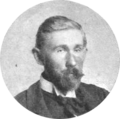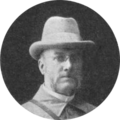File:The Making of a Great Illustrated Newspaper ILN0-1909-1225-0034.jpg

Original file (1,524 × 2,250 pixels, file size: 705 KB, MIME type: image/jpeg)
Captions
Captions
Summary
edit| The Making of a Great Illustrated Newspaper | |
|---|---|
| Artist |
photographs by Russell; Elliot and Fry; Vandyk; Wayland, Blackheath; Reginald Haines; Dinham, Torquay; Pym, Streatham; Fotoco: Castle Fitch; Goodwin; Roger, St. Andrews; Hills and Saunders, Oxford; Maruki, Tokio; E. H. Mills; and R. Johnson. |
| Author |
The Illustrated London News |
| Title |
The Making of a Great Illustrated Newspaper |
| Object type | photographs |
| Description |
English: The Making of a Great Illustrated Newspaper. Illustrations for The Illustrated London News, 25 December, 1909.
Portraits of Gilbert Chesterton, Joseph Pennell, A. Forestier, Melton Prior, Andrew Lang, Russell Flint, Frank Haviland, F. G. Bettany, Frederic Villiers, W. P. Pycraft, Max Cowper, S. Begg, Norman Wilkinson, M. Simont, Cyrus Cuneo, R. Caton Woodville, H. W. Koekkoek, G. C. Wilmhurst, Dr. Andrew Wilson, Frank Reynolds, Charles de Lacy, Charles de Lacy, W. B. Robinson. 'THE MAKING OF A GREAT ILLUSTRATED NEWSPAPER, AN INCREASED CIRCULATION: IT is not the easiest thing in the world to explain why an increased circulation has come into being; but it is possible to divide the causes of this much desired result into two broad principles. A paper such as The Illustrated London News, which has the stability of sale that comes with long establishment and high reputation, has not, of course, the flexibility of a new periodical. Since its conception in 1842, The Illustrated London News has become the mother of a great family of illustrated newspapers, and illustrated journalism is now represented in England by more and better journals than it is in any other part of the world, the United States not excepted. To meet ever-growing competition is difficult; to enlarge the sale in face of it calls for more than exceptional excellence. Why, then, has The Illustrated London News added so considerably to its circulation during the past year ? Has the augmentation been due to any special features, or to general merit ? It is difficult to say. The Editor has received on all sides congratulations upon the way in which contemporary science has been treated in The Illustrated London News, and there is no doubt that the exposition of the outstanding inventions and discoveries of the day in the fields of Science and Natural History has been very popular. The marvellous feats accomplished in aerial navigation., such as Bleriot's cross-Channel flight, have been most amply illustrated; also such interesting subjects as the Gyroscopic Mono-rail, Television, photographs of Halley's Comet, Fog-dispersion, and the cinematographing of microbes. In the field of Natural History our readers will remember, for example, the splendid drawings of wild beasts in Africa by Herr Wilhelm Kuhnert; also such pages as Comedies of Courtship among Animals, the Table Manners of Animals, and Photographing Snakes in their Natural Surroundings. Again, the. bringing to light of ancient civilisations has a romantic interest for all who follow intelligently the working-out of this world's destiny. No important excavation or archaeological discovery is ever passed over in the pages of England's premier illustrated newspaper. We may remind our readers of a few examples of especial interest, such as the discovery of the casket containing ashes of Buddha, the recently found terra-cotta cylinder with fresh records of Sennacherib; the great find in Peru of pre - Inca pottery, the discoveries made by Dr. Stein in Turkestan, the bones of the earliest known man, and the excavations of the walls of Jericho. This archaeological feature of the paper in particular willbe maintained during the coming year, details and photographs of many astounding discoveries of the ancient world being now in the hands of the Editor a ul in course of preparation for publication. Art, both ancient and modern, has been dealt with more fully than heretofore, and especially we may recall to the minds of our readers the part played by The Illustrated London News in the most interesting controversy of modern times, concerning the authenticity of the " Leonardo " wax bust. The paper has also taken a leading part in stirring public enthusiasm for the,retention in this country and national acquisition of famous works of art, such as Holbein's "Duchess of Milan," in danger of export to other lands. Then, too, many famous art-collections, such as that of the late Mr. George Salting, have been fully illustrated, as well as occasions such as the opening of the Victoria and Albert Museum. In politics it has always been the editorial policy to take up no partisan attitude, and thus, though every phase of contemporary political history is illustrated, no bias of any sort is shown. In the illustration of foreign events The Illustrated London News has always been pre-eminent, and it is our fixed purpose that we shall, as long as good artists exist, and a good staff of correspondents with a knowledge of sketching and photography can be obtained, retain the premier position. Travel has always had a special place in the pages of The Illustrated London News, as witness the first publication in an illustrated weekly of Sir Ernest Shackleton's photograph of the furthest point South, and the great number of illustrations given of that and other famous journeys of exploration, above all the Peary-Cook controversy, the travels of Dr. Sven Hedin in Tibet, the exploits of Mr. and Mrs. Bullock Workman on the roof of the world, the Himalayas, and the tragic fate of Mr. Brooke in Chinese Turkestan. Early next year we can promise our readers one at least of the most sensational series of photographs of the most import ant recent event in the history of travel. The theatre, now of universal interest, is invariably well represented in The Illustrated London News by drawings of all the most interesting plays, and portraits by that wonderful artist of character, Mr. Frank Haviland. Among his best efforts, our readers will remember his magnificent drawing of Sir Herbert Tree as the High Priest in "False Gods." We can promise a particularly interesting series next year. The social side of modern life has been fully dealt with, and everything that may be of interest to the well-read and intellectual woman has been illustrated by such masterly exponents of the black-and-white art as Monsieur Simont, Monsieur René Lelong, Mr. Cyrus Cuneo, and many others. A new feature which has aroused extraordinary interest is the introduction-almost weekly-of a series by great artists illustrating subjects not of a topical nature. Such, for instance, are our series of Duchesses, and the series representing the Great Love Stories of the world. During the next year this feature will be continued, and we can promise pictures by Pennell, Wilmshurst, Detmold, S. H. Sime, and other equally well-known masters of the brush. There is no need to tell our readers what a hold Mr. Chesterton and Mr. Andrew Lang have upon the interest and sympathies of all who read " Our Note-Book" and "At the Sign of St. Paul's "-the two best-read articles appearing in any periodical at the present day. We leave it to our readers to decide whether it is to any one of these features, or to all of them taken together, that must be attributed the greatly increased sale of England's premier illustrated newspaper. Photographs by Russell; Elliot and Fry; Vandyk; Wayland, Blackheath; Reginald Haines; Dinham, Torquay; Pym, Streatham; Fotoco: Castle Fitch; Goodwin; Roger, St. Andrews; Hills and Saunders, Oxford; Maruki, Tokio; E. H. Mills; and R. Johnson. |
| Date |
25 December 1909 date QS:P571,+1909-12-25T00:00:00Z/11 |
| Medium | |
| Place of creation | London |
| Source/Photographer | The Illustrated London News |
| Other versions |
|
Licensing
edit|
This is a faithful photographic reproduction of a two-dimensional, public domain work of art. The work of art itself is in the public domain for the following reason:
The official position taken by the Wikimedia Foundation is that "faithful reproductions of two-dimensional public domain works of art are public domain".
This photographic reproduction is therefore also considered to be in the public domain in the United States. In other jurisdictions, re-use of this content may be restricted; see Reuse of PD-Art photographs for details. | |||||
File history
Click on a date/time to view the file as it appeared at that time.
| Date/Time | Thumbnail | Dimensions | User | Comment | |
|---|---|---|---|---|---|
| current | 17:08, 28 February 2023 |  | 1,524 × 2,250 (705 KB) | Broichmore (talk | contribs) | {{Artwork |artist = photographs by Russell; Elliot and Fry; Vandyk; Wayland, Blackheath; Reginald Haines; Dinham, Torquay; Pym, Streatham; Fotoco: Castle Fitch; Goodwin; Roger, St. Andrews; Hills and Saunders, Oxford; Maruki, Tokio; E. H. Mills; and R. Johnson. |author = The Illustrated London News |title = The Making of a Great Illustrated Newspaper |object type = photographs |description = {{en|1= The Making of a Great Illustrated Newspape... |
You cannot overwrite this file.
File usage on Commons
The following 23 pages use this file:
- File:ILN0-1909-1225-0034-01 Gilbert Chesterton.jpg
- File:ILN0-1909-1225-0034-02 Joseph Pennell.png
- File:ILN0-1909-1225-0034-03 A. Forestier.png
- File:ILN0-1909-1225-0034-04 Melton Prior.png
- File:ILN0-1909-1225-0034-05 Andrew Lang.jpg
- File:ILN0-1909-1225-0034-06 Russell Flint.png
- File:ILN0-1909-1225-0034-07 Frank Haviland.png
- File:ILN0-1909-1225-0034-08 F. G. Bettany.png
- File:ILN0-1909-1225-0034-09 Frederic Villiers.png
- File:ILN0-1909-1225-0034-10 W. P. Pycraft.png
- File:ILN0-1909-1225-0034-11 Max Cowper.png
- File:ILN0-1909-1225-0034-12 S. Begg.jpg
- File:ILN0-1909-1225-0034-13 Norman Wilkinson.png
- File:ILN0-1909-1225-0034-14 M. Simont.png
- File:ILN0-1909-1225-0034-15 Cyrus Cuneo.png
- File:ILN0-1909-1225-0034-16 R. Caton Woodville.jpg
- File:ILN0-1909-1225-0034-17 H. W. Koekkoek.png
- File:ILN0-1909-1225-0034-18 G. C. Wilmhurst.png
- File:ILN0-1909-1225-0034-19 Dr. Andrew Wilson.png
- File:ILN0-1909-1225-0034-20 Frank Reynolds.png
- File:ILN0-1909-1225-0034-21 Charles de Lacy.png
- File:ILN0-1909-1225-0034-22 W. B. Robinson.png
- File:The Making of a Great Illustrated Newspaper ILN0-1909-1225-0034.jpg
Metadata
This file contains additional information such as Exif metadata which may have been added by the digital camera, scanner, or software program used to create or digitize it. If the file has been modified from its original state, some details such as the timestamp may not fully reflect those of the original file. The timestamp is only as accurate as the clock in the camera, and it may be completely wrong.
| JPEG file comment | Created by AccuSoft Corp. |
|---|





















